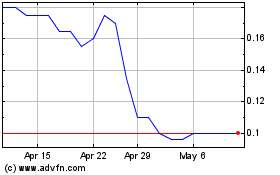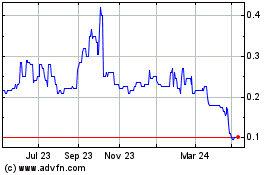New Data Demonstrate VTI’s Multifocal Contact Lenses Effective in Reducing Myopia Progression in Children by 96%
October 24 2017 - 7:47PM
Business Wire
Data show VTI’s unique extended depth-of-focus
center-distance contact lenses may decrease, halt and even reverse
myopic progression in children
Visioneering Technologies, Inc. (ASX:VTI) today announced
the positive results of a new retrospective case series analysis on
the impact of its NaturalVue® Multifocal 1 Day Contact Lenses
(NaturalVue MF) in children with myopia, or near-sightedness. VTI’s
NaturalVue MF contact lenses feature the innovative Neurofocus
Optics® Technology, which uses an extended depth-of-focus design to
address known optical risk factors associated with the progression
of myopia.
In the study, researchers retrospectively reviewed 32 patients’
records of children ages 6 to 19 years, from 10 U.S.-based practice
locations.1 At initial presentation, the children in the study wore
a mix of vision solutions, including glasses, spherical soft
contact lenses (simple lenses that just correct near-sighted
vision), other brands of soft multifocal contact lenses, or
orthokeratology lenses (hard contact lenses worn overnight while
the child sleeps). All participants had some degree of myopia and
their vision solutions were replaced with VTI’s NaturalVue MF
contact lenses. Their myopia progression was then measured over the
following 6 to 25 months and annualized for direct comparison to
each child’s historical annualized myopic progression, which served
as the control.
The study, which was published in the peer-reviewed journal, Eye
and Contact Lens, documented an approximately 96% reduction
(average of both eyes) of annualized myopic progression in children
aged 6 to 19, with 98.4% of the children showing a decrease in the
rate of worsening of their myopia.1 The most frequent amount of the
reduction in the myopic progression was 100%, meaning that complete
halting of myopia progression was the most common result in the
children. Overall, 81.25% of the children had complete halting of
myopic progression during the time period of the study, including
6.25% demonstrating some reversal of their myopia. These results in
slowing the progression of myopia were achieved while also
providing the children with vision equivalent to that of glasses,
with high levels of comfort. Even children as young as 6 years old
were successfully trained to insert and remove VTI’s contact
lenses.
These findings are particularly significant in that myopia has
reached near global epidemic proportions. The rate of myopia in the
U.S. has doubled since the 1970s2 and has reached 80% or more of
children in a number of Asian countries.3 In Australia, which has
historically enjoyed low rates of myopia, the rate of myopia in
12-year-old children of European Caucasian descent doubled from
2005 to 2011.4 In addition to the increasing prevalence of myopia,
its magnitude has also increased.5 These factors have far reaching
implications since myopia has been identified as the sixth leading
cause of vision loss,6 and has been shown to be associated with
increased risks of myopic macular degeneration, retinal detachment,
glaucoma, and cataract.5
The publication, entitled Case Series Analysis of Myopic
Progression Control with a Unique Extended Depth of Focus
Multifocal Contact Lens, was authored by Jeffrey Cooper+, M.S.,
O.D., F.A.A.O., Brett O’Connor+, O.D., Ronald Watanabe, O.D.,
F.A.A.O., Randall Fuerst, O.D., F.A.A.O., Sharon Berger, O.D.,
C.O.V.D., Nadine Eisenberg, O.D, and Sally M. Dillehay, O.D.,
Ed.D., F.A.A.O, VTI’s Chief Medical Officer. The study’s lead
author, Dr. Jeffrey Cooper, is one of the world’s leading experts
in treating paediatric myopia, and is Professor Emeritus at the
State University of New York College of Optometry.
“Nearly 5 billion people are predicted to be affected by myopia
by 2050,7 the majority of them children. Combined with the enormous
medical and economic costs of treating the serious eye diseases
that come with myopia, myopia deserves the respect of a global
epidemic,” said Stephen Snowdy, PhD, VTI CEO and Executive
Director. “These data combined with VTI’s recently granted patents
in Asia and Australia, and other pending territories, serve to
position VTI as a leader in managing myopia in children.”
__________________________________________
1 Cooper J, O’Connor, B, Watanabe R, Fuerst R, Berger S,
Eisenberg N, Dillehay SM. Case series analysis of myopic
progression control with a unique extended depth of focus
multifocal contact lens. Eye & Contact Lens. 2017;(e-pub prior
to publication, Oct). 2 Vitale S, Sperduto RD, Ferris FL. Increased
prevalence of myopia in the United States between 1971-1972 and
1999-2004. Arch Ophthalmol. 2009;127(12):1632-1639. 3 Saw SM, Tong
L, Chua WH, et al. Incidence and progression of myopia in
Singaporean school children. Invest Ophthalmol Vis Sci.
2005;46(1):51-57. 4 French AN, Morgan IG, Burlutsky G, Mitchell P,
Rose KA. Prevalence and 5- to 6-year incidence and progression of
myopia and hyperopia in Australian school children. Ophthalmology.
2013;120:1482-1491. 5 Flitcroft Dl. The complex interactions of
retinal, optical and environmental factors in myopia aetiology.
Prog Retin Eye Res. 2102;31(6):622-660. 6 Cooper J, Schulman E,
Jamal N. Current status on the development and treatment of myopia.
Optometry. 2012;83(5):179-199. 7 Holden BA, Fricke TR, Wilson DA,
Jong M, Naidoo KS, Sankaridurg P, Wong TY, Naduvilath TJ, Resnikoff
S. Global prevalence of myopia and high myopia and temporal trends
from 2000 through 2050. Ophthalmology. 2016;123(5):1036-1042.
+ Advisor to VTI
MKT-VTI-PR42 r1
View source
version on businesswire.com: http://www.businesswire.com/news/home/20171024006831/en/
Visioneering Technologies, Inc.Layna L. MendlingerExecutive
Director of Marketinginfo@vtivision.com
Visioneering Technologies (ASX:VTI)
Historical Stock Chart
From Dec 2024 to Jan 2025

Visioneering Technologies (ASX:VTI)
Historical Stock Chart
From Jan 2024 to Jan 2025
